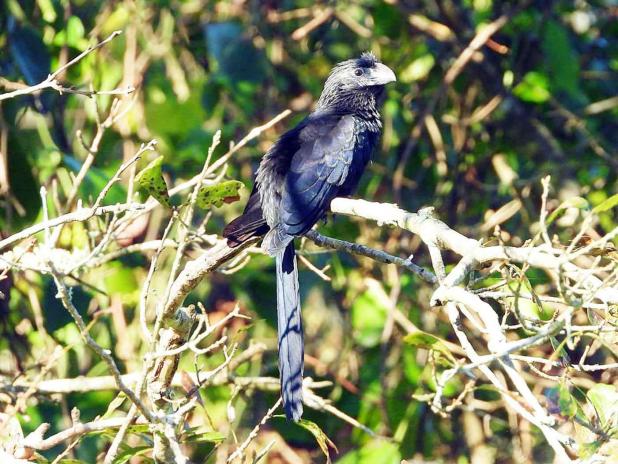
Submitted Photo/Courtesty of Michael Musumeche
Michael Musumeche took this picture of the grooved-billed ani on Bayou Teche NWR the day after Schaub reported it on eBird.
John Flores: Bayou Vista man makes rare bird sighting
Cornell Lab of Ornithology held its 2021 October Big Day recently. Participants were required only to have an eBird account and report any birds they sighted in the midnight to midnight 24-hour period. The time spent birding could be as little as 10 minutes.
Paul Schaub, Bayou Vista resident and president of the Terrebonne Bird Club, spent the day birding with a few friends participating in the event. Schaub said his group of four birders were mainly looking for migrating warblers.
After making four or five stops that included seeing yellow warblers, magnolia warblers, American red starts and gray catbirds, the foursome wound up birding near Bayou Teche National Wildlife Refuges’ Palmetto Trail. What happened next was totally unexpected.
Schaub says he normally stops at the first tree line as you pull onto the refuge’s access road. Around 50 or so indigo buntings flew up out of the tall waste-high grass near the sugar cane, piquing the groups’ interest.
Getting out of the vehicle, they started birding along the access road. It just so happened Schaub was lagging behind the other three members of his party a short distance, when suddenly, a Grooved-billed ani flew by.
Schaub said, “I tried to call them, but at first they didn’t believe me. So, I went and got my camera out of the truck and my phone. We saw it good, and we had some good looks at it.”
According to George H. Lowery Jr.’s Third Edition of Louisiana Birds, the grooved-billed ani is considered an uncommon but regular winter resident in Louisiana. It is most often seen in early winter in southern Louisiana, particularly in Cameron and Plaquemines parishes.
Schaub says over the last five or six years he has seen grooved-bills three other times, but always in the Houma area. In fact, in doing a Louisiana eBird review, Schaub couldn’t find a single sighting of a Grooved-billed ani in St. Mary Parish on record.
When Schaub finally got online to post his list of Big Day birds, eBird flagged the Grooved-billed Ani as a rare sighting. Schaub provided comments of the sighting and he also attached a picture.
One of the results of Schaub’s eBird and Facebook posts was it caused several groups of people and nature photographers to come from Lake Charles and New Iberia to try and capture a look and a photo of the rare bird.
The grooved-billed ani is a bird that is approximately the same size as a common grackle. For reference, if you do any shopping at Walmart, grackles are the large, long-tailed black birds that always hang around in the trees and parking lot there.
The grooved-bill ani is a year-round resident of Mexico, Central America and the southern-most tip of Texas from South Padre Island west to Del Rio.
Schaub, who works for the St. Mary Parish government at Fairview Treatment Center, has been actively birding mainly on weekends for the past 10 years. According to Schaub, he used to be an avid fisherman. What got him interested in birding was while fishing one day, he took a picture of what he thought was a northern cardinal.
When he got home and processed the picture it turned out to be a summer tanager. He’d never seen one before and that sparked his interest. Afterward, Schaub and his wife Carol began looking for a birding club to join and ultimately joined the Terrebonne Bird Club. Since joining, Schaub now has an eBird list with over 300 species sighted.
Schaub said, “I was teetering on 300 and when we went on vacation in Colorado this past summer, I got like 12 or 15 more birds over there.”
Those who participated in the 2021 October Big Day also were part of the second-ever Global Bird Weekend. During the 2021 October Big Day/Global Bird Weekend, more than 33,524 participants submitted 80,132 checklists reporting 7,289 species.
The United States, hands down, provided the most checklists, totaling 33,939. The next closest was Canada with 6,296.
The species leader was Columbia with 1,347 species sighted. In the United States, there were 688 species reported sighted, which was good enough for 11th place out of 195 countries posting checklists.
